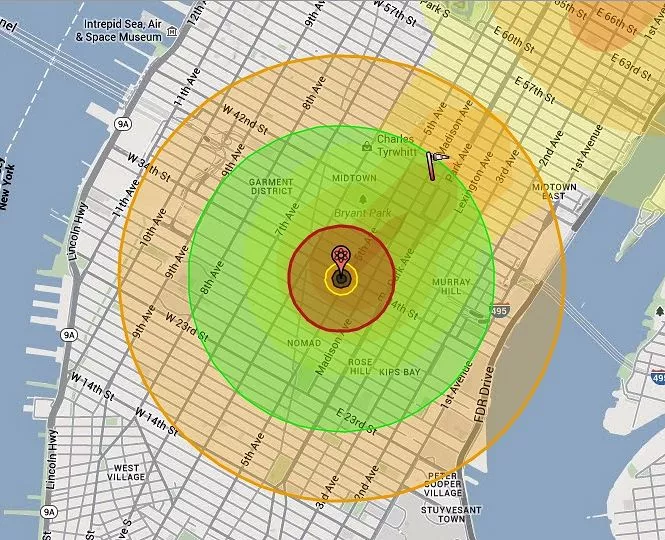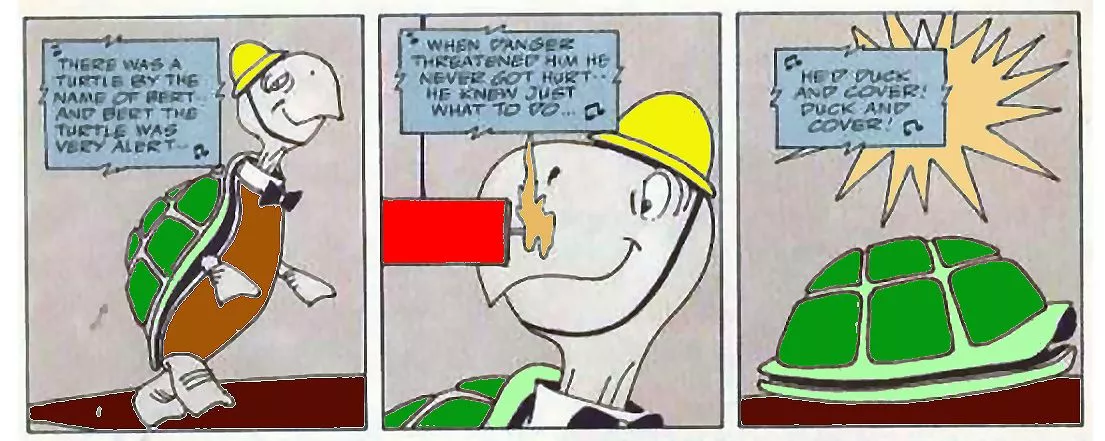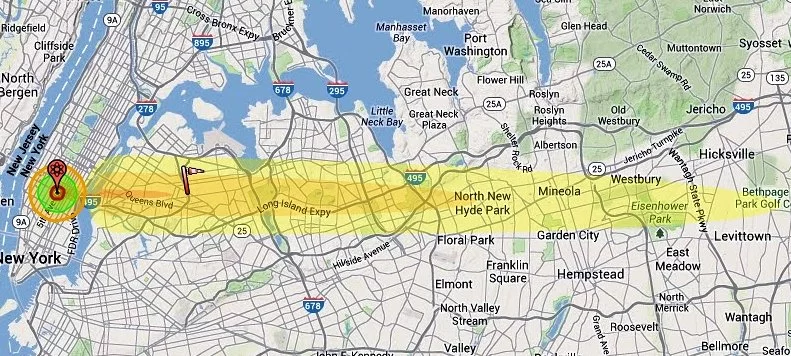The best advice for surviving a nuclear bomb is to be somewhere else when it goes off. If that doesn't work out for you, though, a recent study carried out at the US Department of Energy's (DOE's) Lawrence Livermore National Laboratory (LLNL) provides some simple guidance for maximizing your chances of survival.
In a world where terrorists or small states may be able to muster a 1-10 kiloton nuclear attack, a prudent individual might find it worthwhile to decide a course of action ahead of time. LLNL's Michael Dillon had been studying nuclear shelters for many years when his family asked what they should do if they see a nuclear mushroom rising over their city. Not having a good answer, he began putting together survival models. It turns out that the decades-long advice to shelter in place is not necessarily the best plan for survival.
The first step in surviving is making it through the initial detonation. A credible threat is a 5 kiloton pure fission explosion that detonates in a building at a height of 60 m (200 ft). The energy of the explosion is distributed between blast (about 50 percent), thermal radiation (about 35 percent) and ionizing radiation (about 5 percent in the initial burst, and about 10 percent in fallout.)

Using NUKEMAP to model the effects of the explosion, the figure above shows the effects of the blast if located in the Empire State Building in Midtown Manhattan. The inner black circle is the size of the crater, and the red ring marks the edge of the 20 psi overpressure zone, wherein most buildings will be destroyed. The green ring marks the zone where an unprotected person will receive a marginally lethal dose of prompt radiation, and the peach ring, which has a radius of 1 mile (0.62 km), is the region in which second-degree thermal burns are likely. Outside of this region an unprotected person has a decent chance of surviving the prompt effects of the blast, if they don't get hit by debris (Duck and Cover!)

The expected death toll from prompt effects, such as blast, heat, and the initial burst of radiation, depends on the city and location within the city. Prompt effects from the New York city blast shown above would kill nearly a quarter million people, while if the same blast were centered on downtown Albuquerque (a spread-out small city with a well-defined downtown) the prompt death toll would be about 15,000.
Assuming one has survived these early effects (although you may not be sure about survival until a couple of weeks have passed), the next object is to avoid being killed by radiation exposure from the fallout. Exposure to radiation is measured in a variety of units; here we will use rems (Roentgen equivalent man) and rems/hr. The lethal dose is about 500 rems. (Another commonly used unit for radiation exposure is the Gray (Gy), which is equal to 100 rem.)
The fireball is 760 ft (230 m) in diameter, large enough to touch the ground, producing substantial local fallout. The mushroom cloud climbs for a period of about five minutes, reaching an altitude of about 3 miles (4.8 km) and a diameter of about 2 miles (3.2 km). The total amount of radioactive material resulting from a 5 kt explosion is only about 1 lb (0.5 kg), but that material is extremely radioactive.

Fortunately, the fallout is not evenly spread. The most intense radiation products for this size of blast remain within the prompt kill zone of the bomb. Assuming a wind speed of 10 mph (16 km/h), the fallout is distributed over a narrow plume, as shown in the figure above. The area in which the radiation exposure rate is between 100 and 200 rem/h reaches about 4 mi (5.4 km) downwind of the detonation, but is only 0.33 mi (0.54 km) wide. For a rate of 10-100 rem/hr, the region is 15 mi (24 km) long and 1.5 mi (2.4 km) wide, and for a rate of 1-10 rem/hr, it is 26 mi (42 km) long and 2.8 mi (4.5 km) wide.
Should I stay or should I go?
Now comes the question: What will you do? The official US government guidance is to shelter in place. You go to the nearest and most protective building and stay there for 24 hours unless told to evacuate sooner. This isn't bad advice if your immediate shelter is the basement of a more or less intact house, which can reduce radiation levels by a factor of ten or so. However, if the blast occurs in Los Angeles rather than in New York, the lack of a frost line allows most houses to be built without basements. Such houses only block about half the fallout radiation.
Taking into account the decay rate of the fallout, a location with an initial exposure rate of 200 rem/h (about the highest dose rate for fallout from a 5 kt device) will receive a total radiation exposure of over 600 rem in the first 24 hours. If sheltering in a NYC concrete basement, a person's exposure in this period would be about 60 rem, an exposure having little immediate health consequence. However, in an LA ranch house, over 300 rem would be absorbed in that same 24 hour period, which would prove an eventually lethal dose for a substantial number of victims receiving little or no medical care, particularly if combined with flash burns and blast debris injuries. It would appear that sheltering in place is not necessarily the best advice, depending on local circumstances.
Another factor to consider is, if the wind direction is constant, it shouldn't take long to leave the worst of the fallout plume by walking perpendicular to the plume. It also requires time for radioactive materials to fall to the ground, even near the blast site. This can provide a short period during which radiation exposure is not the greatest concern. Instead, dodging falling buildings, debris, and fires is likely the biggest risk in this early post-blast environment. Still, there is time and opportunity to take a different course than simply sheltering in place.
It is this opportunity that Mike Dillon decided to analyze. He developed a complex mathematical model describing the radiation exposures associated with different post-blast behaviors, then simplified the results so they can be used by anyone to choose a survival strategy.
The key factor is how long it would take to get to an adequate shelter. For a 5 kt blast, adequate shelter is essentially either a standing multi-story building (shelter is best in the mid-upper floors), near the center of a large concrete or brick building, or in a structurally sound basement.
If it would take you less than five minutes to reach adequate shelter, go there immediately following the immediate blast effects. In the end, the better shelter will offset your brief exposure to higher levels of radiation.
If adequate shelter is less than 15 minutes away, shelter in place for no more than 30 minutes, then transfer to the better shelter. Again, the combination of a short period of immediate shelter combined with a move to better shelter will offset your exposure during the move (at least statistically).
The choice of a 5 kt nuclear device was intended as something that could be made by terrorists or small states with a minimum of sophisticated design. As a result, if positioned more than a mile from the detonation, a person has a pretty good chance of surviving the attack. Even the area over which large areas of fallout land are quite small, with the 100 rem/h contour taking in about 1.5 sq mi (3.8 sq km).
The story would be quite different if a Minuteman or Trident-class weapon were stolen, as these have yields in the general vicinity of 300 kt. Such a device would have a prompt kill range of about 5 miles (8 km), causing the deaths of about a million people in the Empire State Building scenario. The 500 rem/h fallout contour includes some 50 sq mi (130 sq km), and the 100 rem/h region covers some 400 sq mi (1,036 sq km). Despite the enormous size differences, Dillon's rules still can help. It is just that many more people would die of fallout regardless of their course of action.
Should a nuke ever be detonated in a city anywhere in the world, the results would obviously be enormous, but of similar dimensions to the largest weather-related disasters and earthquakes. We would survive, but it would be a blow never to be forgotten. Let's hope we never go there.
Source: Proceedings of the Royal Society




